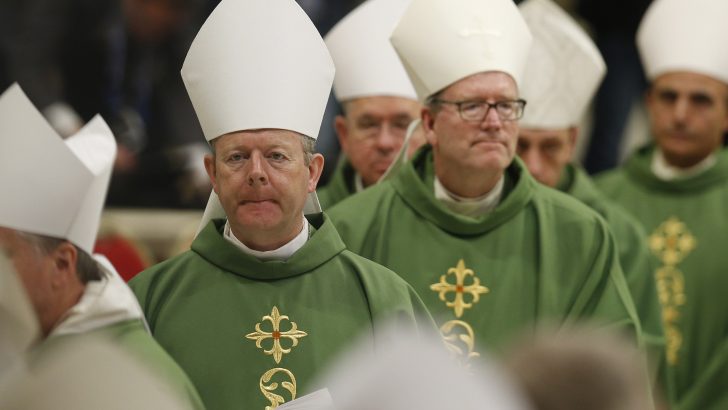Many Catholics would be unaware of the process of a synod, let alone the details of the recently published final document of the synod on youth – but it heralds big changes in Ireland’s Church.
Irish Catholics are set to become much better acquainted with synods and synodality, and not just as a distant process or concept coming from Rome, according to Archbishop Eamon Martin.
The final document of the Synod of Bishops on ‘Young People, the Faith and Vocational Discernment’ was released on Saturday, initially in Italian, and concludes a process that began two years ago. The new ecclesiology that’s been put in motion by Pope Francis and this synod signals a Church that “walks with” and listens to young people, gives women more decision making roles and moves away from governance from the top.
The inspiration for the final document, and for synods in general, comes from the story of the Road to Emmaus in the Gospel of Luke in which Jesus listens and teaches.
“As Pope Francis himself said on Saturday the document is not the end of the synod,” Archbishop Martin told The Irish Catholic. “There seemed to be a great consensus that all of us needed to bring this home now, and continue the conversation in our own countries, and that resonated with me because this is something that I had said quite early on.”
The idea of a ‘synodal’ Church “is one which journeys and engages with its people at all levels, and it becomes a listening Church”.
“Pope Francis himself was anxious to clarify that he’s not talking about some kind of parliamentary Church where the maximum number of votes decides the Church’s teachings on various issues. But he does believe that the Church in the 21st Century, if it is truly to be Church, it must be a synodal Church, journeying with its people,” Dr Martin said.
“Therefore I’m bringing back from the synod not only some concrete ideas about pastoral strategies that will engage youth, but I’m also bringing back this question about how can we in Ireland become a more synodal Church.
“In other words are we using all of the instruments that are already there effectively? For example parish pastoral councils, diocesan pastoral councils, are we using councils of clergy and is there sufficient engagement, listening and consultation going on at grassroots level within the Church in Ireland?”
Dr Martin will be bringing this question to the next meeting of the Irish Catholic Bishops’ Conference in December.
The synod on youth, which ran for almost a whole month from October 3-28, was unique in that it included 36 young people aged 18-29 who were an integral to discussions according to both Dr Martin and Bishop Donal McKeown.
Although they were unable to vote on the final document, the young people informed discussion and were also involved in a pre-synod gathering. This was a weeklong process in which youth from around the world met in Rome to discuss the 60,000 answers given by young people to an online survey that began in January 2016.
From this discussion the Instrumentum Laboris ‘Working Document’ was created and used to frame the synod’s discussions.
Dr Martin said the synod for him was encouraging a “preferential action” for young adults, particularly those aged 18-30, to take up leadership roles at “all levels” of the Church
The issue of passing on the Faith in a meaningful way was also an “area for pastoral action” he said, particularly following the World Meeting of Families and the synod, and that a charismatic catechises is needed.
“Normally we have tended to talk about catechisis, which is really about making sure that everybody understands the Catholic Faith. But a charismatic catechises is one which does that in the context of building a love for Jesus Christ, a personal encounter with Christ of the Gospel. In other words it’s not just learning facts and foundational knowledge and understanding but it is doing so as people of Faith,” Dr Martin said.
“The synod has been trying to tackle the two of those: how do we present the Catholic Faith in a way which appeals to the heart of young people but also appeals to their heads, both of those things are carried together, and finally appeals to the hands.
“In other words sends them out in concrete Catholic social action: working amongst the poor, engaging in mission, trying to transform temporal affairs, in other words, the world of media, politics, the world of healthcare, the world of the family…bringing your Faith to bear in a concrete way in your life.”
Engaging
As part of the synod process, the final document of the synod on youth was read out and voted on paragraph by paragraph – 167 paragraphs altogether – with each needing a two-thirds majority to pass.
Archbishop Eamon said that it was a “significant happening” that every paragraph passed despite the differences in culture and experience of bishops around the world, with a large amount passing by a margin of 90%. Altogether there was 249 synod fathers voting, which means at least 166 were needed for a paragraph to pass.
It is now up to the Pope to decide what to do with the final document.


 Chai Brady
Chai Brady Archbishop Eamon Martin and other prelates leave the closing Mass of the Synod of Bishops on young people. Photo: CNS
Archbishop Eamon Martin and other prelates leave the closing Mass of the Synod of Bishops on young people. Photo: CNS 